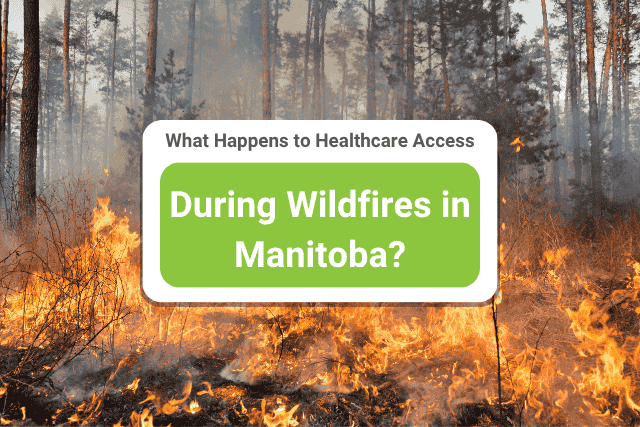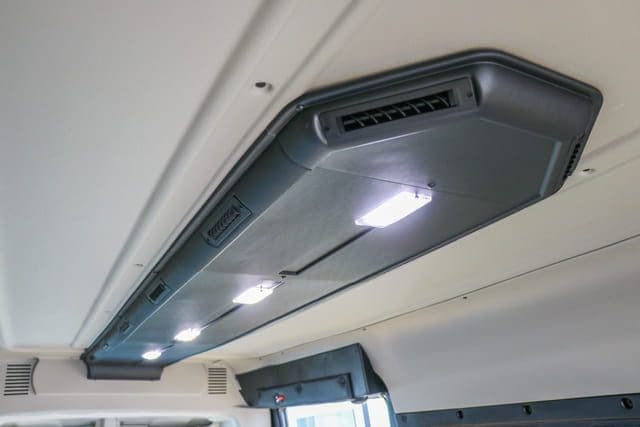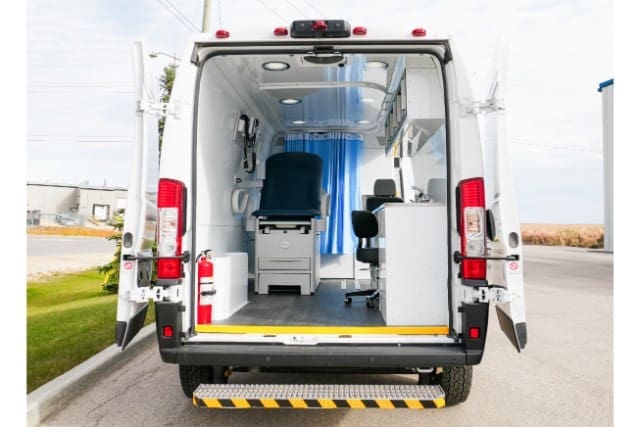Wildfires in Manitoba have forced thousands of people from their homes. Right now, over 17,000 residents have had to leave towns like Flin Flon and Thompson because of the fires. Clinics are closed, hospitals are moving patients, and care homes are relocating residents. Even breathing is harder, with smoke filling the air and causing health issues.
If your organization helps people during emergencies, you’re probably worried. You might feel helpless, wondering how to support communities dealing with the current wildfires in Manitoba. Doing nothing puts people’s lives at risk, especially those who need regular healthcare.
The good news is that your team can make a difference, either now or in the future. Mobile medical units can reach people, even if roads are closed and local clinics shut down. With these vehicles, healthcare access continues, helping communities stay healthy during difficult times.
At MoveMobility, we’ve built safe, reliable medical vehicles for over 20 years. Our vehicles have special safety certifications like Ford QVM, Stellantis QPro, and Canada’s National Safety Mark. Healthcare providers like Quest Community Health Centre and nonprofits across Canada trust us because we build what communities truly need.
In this article, you’ll learn:
- How wildfires in Manitoba impact healthcare
- The problems communities face during these emergencies
- Ways your organization can help during future wildfires
Manitoba wildfire crisis: Key statistics (as of June 5, 2025)
| Metric | Data |
| Total active wildfires in Manitoba | 23 active fires across the province |
| Fires classified as ‘out of control’ | Over 100 wildfires nationwide are deemed “out of control” |
| Area burned in Manitoba | Over 198,000 hectares burned, nearly triple the five-year annual average |
| Evacuations in Manitoba | Approximately 17,000 residents evacuated, including entire communities like Flin Flon |
| Total evacuations in Canada | Over 33,400 people evacuated across Manitoba, Saskatchewan, and Alberta |
| Air Quality Index (AQI) Levels | AQI levels have reached “very unhealthy” levels (e.g., 228 in Williamstown, MA) due to smoke |
| Smoke dispersion | Smoke has spread across one-third of the U.S., affecting air quality from the Midwest to the East Coast, and has reached Europe |
| Healthcare disruptions | Clinics closed, hospitals evacuated, and care homes relocated due to fire threats and smoke |
| Mental health impact | Increased anxiety, stress, and PTSD symptoms reported among evacuees and healthcare workers |
How do wildfires in Manitoba impact healthcare?
The wildfires in Manitoba today are causing big problems for people who need healthcare. Towns are being evacuated, hospitals are closing, and smoke is making it hard to breathe. It’s not just about putting out the fires; it’s also about keeping people healthy and safe.
Hospitals and care homes are closing
In places like Flin Flon, hospitals and care homes had to move all their patients to other towns like Winnipeg and Brandon. That’s a huge job, and it means people are farther away from their doctors and caregivers.
Healthcare services slow down
Wildfires in Manitoba can make it hard for healthcare workers to do their jobs. Some roads are closed, and it’s not always safe to travel.
Here’s what happens:
- Clinics shut down: Fire and smoke force them to close
- Emergency help is delayed: Ambulances can’t always get through
- More people in fewer hospitals: Evacuees crowd nearby health centres
Smoke makes breathing harder
The smoke from the current wildfires in Manitoba spreads across the province and even into the U.S. This smoke can be dangerous, especially for kids, older adults, and people with asthma or heart problems.
Mental health takes a hit
Having to leave your home suddenly is scary. People feel worried, sad, and stressed. But getting mental health help during wildfires in Manitoba isn’t always easy when services are busy or closed.
Northern and Indigenous communities are hit harder
Many northern and Indigenous communities are remote. That means they’re already far from hospitals, and wildfires make things worse. Help can take longer to arrive, and some people may feel forgotten.
Moving supplies gets tricky
Hospitals and clinics need medicine, masks, and bandages. But when wildfires in Manitoba close highways, trucks can’t always get through, slowing down the delivery of important supplies.
The current wildfires in Manitoba show how quickly healthcare can fall behind in an emergency. That’s why it’s so important to have mobile healthcare options ready to go so no one is left without care when they need it most.
Healthcare workers are stretched thin
When wildfires hit, many healthcare staff were also evacuees. They were caring for their families and may not have been able to report to work, leaving fewer people to care for more patients.
This creates a ripple effect:
- Fewer nurses and doctors means longer wait times
- Less local knowledge if new staff are brought in from other areas
- Burnout sets in fast for those still working long shifts in tough conditions
Routine care disappears
During wildfires in Manitoba, everyday healthcare is often pushed aside. Appointments for check-ups, therapy, or chronic conditions are canceled or delayed. This may not sound urgent, but it can become urgent fast.
People affected most:
- Seniors needing home care
- People with diabetes or high blood pressure
- Kids missing vaccines or regular checkups
What problems do communities face during wildfires in Manitoba and other natural disasters?
When wildfires in Manitoba or other natural disasters strike, it’s not just fire crews that scramble. Whole communities get shaken up. And often, the problems that follow are worse than the fire itself.
Healthcare is suddenly out of reach
In remote areas like Garden Hill or Shamattawa, it’s already tough to get to a doctor. Add fire or flood, and now people can’t travel at all. Roads shut down. Planes and ferries stop running. Even basic care becomes a huge challenge.
Here’s what that can mean:
- People miss appointments that keep their conditions stable, such as dialysis
- Emergency care is delayed by hours, or more
- Medicines and supplies run out with no quick way to restock
Evacuations throw life off course
Getting the call to leave your home with just a bag and no idea where you’re going? That’s the reality for thousands during the current wildfires in Manitoba. People are sent to unfamiliar places, sometimes for weeks.
It causes:
- Anxiety and confusion, especially for kids and seniors
- Missed mental health and addiction support
- Stress from being separated from family or caregivers
Local healthcare gets overloaded
Communities receiving evacuees, like Winnipeg, Brandon, or The Pas, don’t always have the staff or space to keep up. Clinics that usually see 20 people a day might now see 100.
What happens next?
- Long wait times
- Tired staff and burnout
- Fewer resources to go around
Vulnerable people face bigger risks
People who use wheelchairs, have vision loss, or rely on daily home care can be left behind. Many shelters aren’t set up for accessibility, and not every vehicle used in evacuation is built to accommodate different needs.
So when wildfires in Canada shut things down, the biggest problem isn’t just the fire. It’s how fast everything else breaks apart, especially for people already dealing with tough health challenges. Up next: let’s talk about how your team can help. Ready?
How can your organization help during wildfires in Manitoba and other future natural disasters?
When wildfires or other natural disasters strike, communities often find themselves cut off from essential services. At MoveMobility, we offer solutions that organizations like yours can use to bring care directly to those in need. In times like these, you often have to take healthcare directly to the communities impacted, where they are, when they need it.
Here’s how:
Provide mobile healthcare with a mobile clinic
During wildfires in Manitoba, people often lose access to their local clinics or health centers.
- Roads close
- Facilities shut down
- Medical staff are evacuated
In those moments, a Mobile Clinic Van becomes an essential tool you can use to help those in need.
Mobile Clinic Vans are vehicles built to bring healthcare to people, right where they are. These vans include an exam bed, secure medication storage, climate control, an optional sink or fridge, and medical tools for checkups and basic care. They can be parked in a school lot, near an evacuation shelter, or outside a hotel where evacuees are staying.
This kind of van is perfect for situations like the current wildfires in Manitoba because it solves the biggest problem: distance. People don’t have to figure out how to get to care because it comes to them. A nurse, doctor, or paramedic can use the space to treat wounds, manage chronic conditions, and even help with minor emergencies.
You can also use these vans to:
- Help people refill prescriptions
- Give check-ups to children or seniors
- Offer care to folks with limited mobility
Mobile Clinic Vans are made for flexibility. One day, they might serve as walk-in clinics, and the next day, they might support first responders in remote areas.
This is how your organization can be part of the solution during disasters like the wildfires in Manitoba today. It’s not about waiting for people to come to you. It’s about meeting them where they are, with the care they need, when they need it most.
Provide mental healthcare with a Mobile Counselling Van
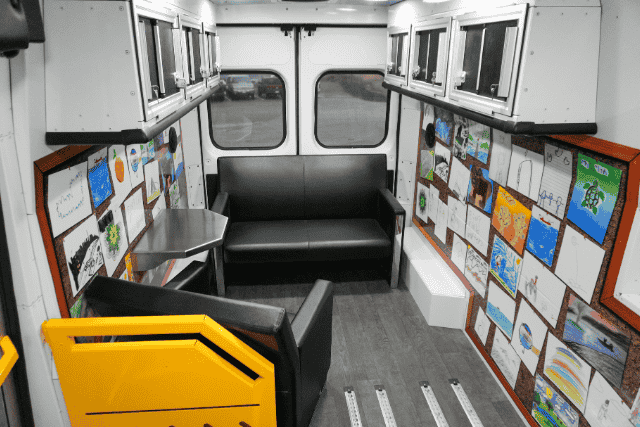
When people are forced to leave their homes during disasters like the current wildfires in Manitoba, the emotional toll can be just as heavy as the physical one. Many are scared, anxious, and unsure of what comes next. Some have lost everything. For others, the stress piles up quickly, especially for kids, seniors, and people already living with mental health struggles.
That’s where a Mobile Counselling Van makes a big difference.
This vehicle is designed to offer a private, welcoming space for people to talk to a counsellor or therapist. The setup is calm and quiet, with soft lighting and comfortable seating. It doesn’t feel like a doctor’s office. It feels like a safe space.
A counsellor can:
- Help evacuees talk through what they’re feeling
- Support people dealing with panic, depression, or grief
- Connect individuals with long-term mental health care
The van can park at evacuation centres, hotels, or anywhere people are staying. Because it’s fully mobile, you can move it between locations as needed. That means mental health support isn’t stuck in one place. It travels to where people need it.
Some vans are even set up for virtual care. So if someone needs to speak with a therapist in another city, they can do that right from the van.
Mental health is under pressure during the wildfires in Manitoba. People need to know they’re not alone. Your organization can bring real comfort and support just by showing up with the right tools, and this van is one of them.
Provide mobile outreach with a Mobile Outreach Van
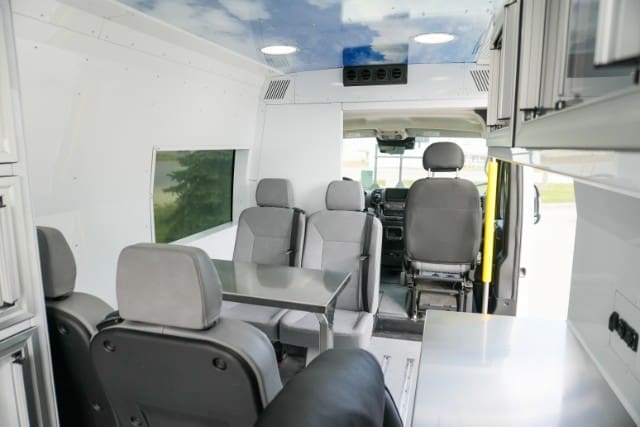
After natural disasters like the wildfires in Manitoba today and the past few weeks, people often don’t know where to go or who to ask for help. They may need food, transportation, health services, or even just someone to guide them through their options. That’s where a Mobile Outreach Van comes in.
This type of van is made to be flexible. It can act as a mobile office, a meeting space, a mobile clinic, a resting spot, or even a transportation unit. You can set it up almost anywhere: outside an evacuation centre, in a rural community, or near a temporary shelter.
Here’s how your team can use it:
- Offer outreach and referrals to other community supports
- Provide transportation to clinics, pharmacies, or safe housing
- Deliver on-the-spot help like food, hygiene kits, or health checks
Mobile Outreach Vans are especially useful for reaching people who might not ask for help on their own. Outreach teams can drive into harder-to-reach places, knock on doors, and connect with those who feel isolated.
These vans are also great for building trust. They feel more personal than a large office or formal facility. People are more likely to approach and talk when support feels close and friendly.
During the Manitoba wildfires, many individuals and families are scattered across unfamiliar areas. Some are in hotels, others in community centres or with relatives. The Outreach Van helps close the gap between those people and the services they urgently need.
With this van, your organization can go straight to the heart of the crisis and bring help with you. It’s not just about showing up. It’s about reaching out and making a difference when people feel lost.
Treat and transport safely with a Mobile Response Van
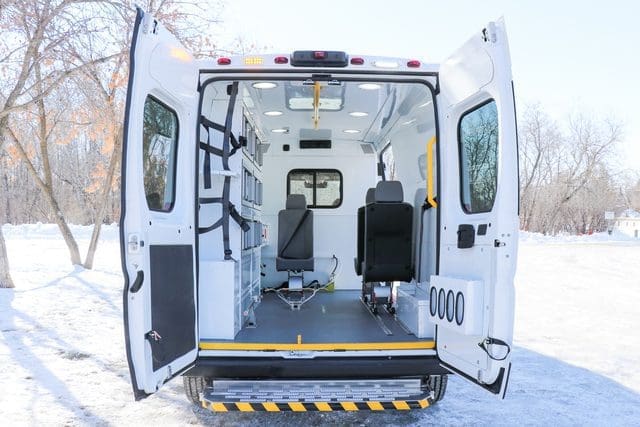
During Canadian wildfires, not every medical need is an emergency, but that doesn’t make it any less important. People still need care for things like minor injuries, chronic conditions, or medication management. That’s where a Mobile Response Van comes in.
This van is an ambulance alternative designed for non-urgent medical care and patient transfers. It’s built inside a full-size van and includes everything your team needs to treat and transport patients safely, without tying up emergency services.
Inside, you’ll find:
- A stretcher with secure transport options
- Attendant seating
- Bright, clean treatment space
- Rear heating and A/C for all-season use
Your team can use the van to:
- Respond to non-critical medical needs during evacuations
- Transfer patients between care homes and hospitals
- Offer basic treatment on-site at shelters or evacuation centres
- Reduce emergency room strain by providing mobile urgent care
The Mobile Response Van doesn’t require special licensing in most provinces and is ideal for rural or remote areas where travel is tough. It’s also a great fit for communities looking to prevent hospital overload while still meeting people’s medical needs on the ground.
Ambulances are often overwhelmed in wildfire emergencies. But with a Mobile Response Van, your organization can fill the gap, treating patients where they are and transporting them when needed.
It’s not a replacement for critical care, but it’s a powerful tool to keep your community healthy and supported when every second and resource counts.
Ready to support healthcare accessibility during the wildfires in Manitoba or other natural disasters?
You came here because you’re concerned about how Manitoba wildfires disrupt healthcare access. You likely wanted to know how to help communities stay safe and cared for during these emergencies.
After reading this article, you’ve learned:
- The specific challenges communities face during wildfires, including hospital evacuations, disrupted services, and mental health strains.
- How mobile solutions like clinic vans, counselling vans, and outreach vans can address these challenges effectively.
At MoveMobility, we specialize in creating mobile medical and accessible vehicles tailored to meet the unique needs of communities across Canada. With over 20 years of experience, our vehicles are designed to deliver healthcare services directly to those in need, especially during crises like the Manitoba wildfires. Our commitment is to ensure that no one is left without access to essential care, regardless of their location or circumstances.
If you have questions or need guidance on implementing mobile solutions for your organization, click the button below to talk to a mobility expert.
If you’re not ready to talk to a mobility expert yet, we have a few other resources you should check out to learn more.
Start by checking out our article on how mobile clinics can help your community health centre stay operational in emergencies.
After that, learn about what medical equipment you can get in your mobile medical unit.


